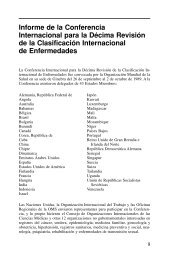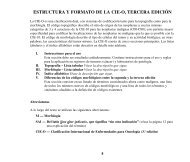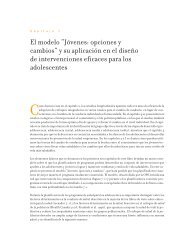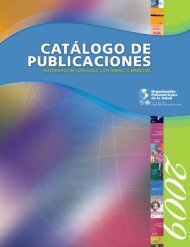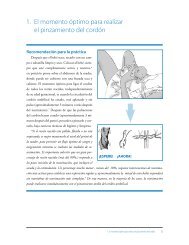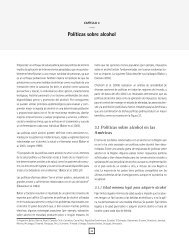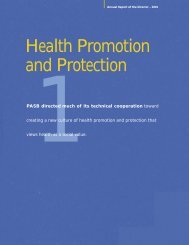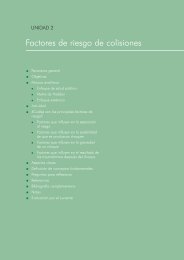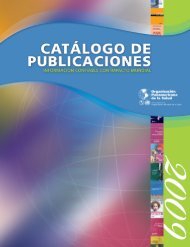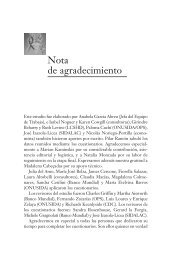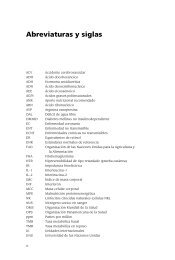Eligibility for Blood Donations PAHO-WHO 2009 Txt
Eligibility for Blood Donations PAHO-WHO 2009 Txt
Eligibility for Blood Donations PAHO-WHO 2009 Txt
- No tags were found...
You also want an ePaper? Increase the reach of your titles
YUMPU automatically turns print PDFs into web optimized ePapers that Google loves.
ELIGIBILITY FOR BLOOD DONATIONPan American Health OrganizationINTRODUCTIONBackgroundIn the Region of the Americas, ef<strong>for</strong>ts have been made to improve the safety andavailability of blood <strong>for</strong> transfusion (1). The work done at the regional level resultedin a significant increase of annual donations and of voluntary blood donations inthe Caribbean and Latin American countries during the first years of the 21st century(Figures 1a and 1b), (1, 2).<strong>Blood</strong> donation in the Caribbean and Latin America 2000–2005Figure 1a900080007000600050004000300020001000Number of annualdonations x 10000 2000 2001 2002 2003 2004 2005Number of annual voluntaryFigure 1b3000250020001500donations x 1000100050002000 2001 2002 2003 2004 20051Recommendations<strong>for</strong> Education and Selection ofProspective <strong>Blood</strong> Donors
ELIGIBILITY FOR BLOOD DONATIONPan American Health OrganizationTable 2Proportion (%) of voluntary blood donations in Latin American countriesCountry 2002 2003 2004 2005Argentina 6 8 7 8Bolivia 24 16 23 28Brazil 47 51 46 53Chile 2 6 7 9Colombia 41 42 50 58Costa Rica 48 49 57 59Cuba 100 100 100 100Dominican Republic 17 18 20 20Ecuador 41 30 29 Not reportedEl Salvador 10 10 11 10Guatemala 4 4 2 1Honduras 22 19 16 15Mexico 3 4 4 4Nicaragua 56 45 42 44Panama 2 2 2 3Paraguay 1 6 6 10Peru 6 5 4 5Uruguay 35 32 26 26Venezuela 11 4 7 7Based on the reports of 28 Caribbean and Latin American countries (4), it is estimatedthat over 1.2 million prospective donors were deferred in 2005. If the donor interviewlasted an average of 15 minutes, the staff in the blood services invested 1,200 hrs. eachworking day in conversations with individuals that were not in condition to donateblood. Furthermore, those donors that were allowed to donate were very likely to carrymarkers of infections that have the potential to be transmitted through bloodtransfusion (median proportion of reactive donors was 3.11%, range 0.03% to 11.00%).In addition to the risk <strong>for</strong> the safety of the blood supply, the 230,000 reactive unitsthat were discarded in 2005 represent US$ 13.4 million in wasted supplies used <strong>for</strong>blood collection and processing (5).The stagnation in the proportion of voluntary blood donors at the regional level,the overall high rates of donor deferral, and the prevalence of infectious diseasemarkers the national level, clearly indicate that the processes involved in blood donorrecruitment and selection need improvement.This is also one of the main conclusions of socio–anthropological studies carried outin 17 countries of the Region of the Americas (6–23). The findings of these surveyswere very similar among them and can be summarized in the following manner:The population:• has a positive attitude towards blood donation;• considers that giving blood is useful;• is willing to help to achieve blood sufficiency;• donates blood when it is necessary;• lacks knowledge about blood donation issues;• is interested in learning more about blood donation;• prefers being given opportunities to donate over material incentives; and• requires transparency of the national blood systems.3Recommendations<strong>for</strong> Education and Selection ofProspective <strong>Blood</strong> Donors
The prospective donors demand in<strong>for</strong>mation on the requirements to become blooddonors, the reasons <strong>for</strong> deferral, the risks and physical consequences of donating blood,the community need of blood, and the places, frequency and procedures <strong>for</strong> blooddonation. The public suggests that workshops and group discussions be used to involvethe community and that mobile collections be implemented to avoid blood collectionin hospitals. The location, working schedule and the environment of the facilities whereblood is currently collected are considered deterrents <strong>for</strong> blood donation, as are the poorservice provided by the staff and the lack of standardized blood collection procedures(6–23).Taking this in<strong>for</strong>mation into consideration the document IMPROVING BLOODAVAILABILITY AND TRANSFUSION SAFETY IN THE AMERICAS (5), presented by theDirector of the Pan American Health Organization to the Directing Council in 2008,recommended that:a. the coutries make ef<strong>for</strong>ts to estimate their annual need <strong>for</strong> bloodand blood components;b. the number of repeat donors be estimated at least as 50% of thenational need of red blood cells;c. a national program be put in place to educate and recruithealthy individuals as regular donors and to have them donate atleast twice a year; andd. a social network of volunteers be established to help educate thecommunity, to promote voluntary blood donation and to servicethe donor.The 48th Directing Council of the Pan American Health Organization (<strong>PAHO</strong>) on2 October 2008 adopted resolution CD48.R7 (24) which urges the Member States to:a. Proactively implement the Regional Plan of Action <strong>for</strong> Transfusion Safety2006–2010 by:i. defining a specific entity within the normative level of their ministriesof health as responsible <strong>for</strong> the planning, oversight, and overallefficient operation of the national blood system;ii. estimating the annual need <strong>for</strong> blood components and the financialresources to cover those needs; andiii. establishing a network of volunteers to educate the community, topromote voluntary blood donation and to service the donors, withspecial attention to youth programs.b. Terminate replacement and paid donation by the end of 2010.c. Terminate mandatory patient replacement of transfused blood by the endof 2010.4
ELIGIBILITY FOR BLOOD DONATIONEducation of prospective blood donorsPan American Health OrganizationThe approach recommended by <strong>PAHO</strong> <strong>for</strong> the education of allogeneic blood donorsrequires a shift in the way the national health systems currently procure blood in mostof the countries of Latin America and the Caribbean.TRADITIONAL APPROACH• The patient needs blood• The hospital orders blooddonations• Relatives and friends of thepatients are required toprovide blood• The blood bank collects theblood specifically <strong>for</strong> a hospitaland/or patient• The hospital uses the bloodNEW APPROACH• The country needs blood• The national communityeducates voluntary blood donors• The health system promotes andencourages blood donation• The blood services cater to blooddonors• The country uses the bloodThe concept that the country needs blood encompasses the estimation of the quantityof blood components that is required to provide appropriate and timely treatment toall the patients, irrespective of their geographic, economic, social and cultural position.It is the hospitals, there<strong>for</strong>e, that should determine the annual, monthly and weeklyrequirements of blood components.The blood services should define the number of blood donors to be educated andprovide the leadership to the national community – Ministry of Health, Ministry ofEducation, Ministry of Labour, academic institutions, churches, patient organizations,human rights organizations, social and sports clubs, municipalities – <strong>for</strong> the educationef<strong>for</strong>ts. The blood donor service staff within the national blood services should traincommunity coordinators and volunteers and support their work to educate the donors(25–31).The desired profile of the voluntary blood donor is “An individual who:• has the capacity and the competence to decide to be a blood donor;• knows that she/he is healthy and wants to remain healthy;• is well in<strong>for</strong>med on the measures to maintain her/his health, on how to avoidunhealthy behaviors and risks;• knows what the need, requirements, process and risks of blood donation are;• is positively motivated to donate blood;• decides voluntarily to donate blood; and• donates blood repeatedly.”5Recommendations<strong>for</strong> Education and Selection ofProspective <strong>Blood</strong> Donors
All the appropriate in<strong>for</strong>mation and the opportunity to ask questions regarding blooddonation should be provided to all prospective blood donors, prior to recruitment, instructured presentations <strong>for</strong> groups of 40–45 individuals.Detailed explanations of the value of blood transfusions, the estimated need of bloodcomponents in the community, the specific processes of donor interview and blooddonation, its physiological consequences and its potential untoward reactions arenecessary during the education phase (32–35). Prospective donors should receivein<strong>for</strong>mation regarding infections transmitted by blood transfusion (TTI) such as theviruses of the human immunodeficiency (HIV), hepatitis B (HBV), hepatitis C (HCV),human T cell-lymphotropic type I and type II (HTLV I/II), Trypanosoma cruzi andmalaria. The in<strong>for</strong>mation should include means of transmission, incubation andwindow periods, signs and symptoms, risk behaviors, preventive measures, and theimportance of withdrawing from the donation if they believe that either the collectionor the transfusion of their blood may pose a risk <strong>for</strong> them or <strong>for</strong> the patients,respectively. The International Society <strong>for</strong> <strong>Blood</strong> Transfusion (ISBT) adopted a Code ofEthics <strong>for</strong> blood donation and transfusion that aims to protect blood donors, bloodrecipients and blood <strong>for</strong> transfusion as a public good (36). The Code should be providedto prospective donors during the education phase.<strong>Blood</strong> services must also in<strong>for</strong>m the donor about the tests that will be per<strong>for</strong>med ondonated blood, under which circumstances the donor will be in<strong>for</strong>med of test results,and what in<strong>for</strong>mation will be released to third parties. Donors have the right to bein<strong>for</strong>med in a timely manner of any medically significant abnormalities that may bedetected during the interview and the general health asessment (37, 38). <strong>PAHO</strong>recommends that any clinically significant findings detected during the pre–donationevaluation or during the blood testing should be released. <strong>Blood</strong> services should refer<strong>for</strong> appropriate follow–up donors who have indications of clinically significantconditions, including reactive infectious markers. It is vital, however, that test resultsnot be used as a motivational tool <strong>for</strong> blood donation, as this would encouragedonations from people who engage in risky behaviours, thereby increasing thepossibility of TTI (39, 40). Prospective blood donors should also be explained abouttheir rights and those of the patients that may receive blood transfusions (41–49).At the end of the education session, prospective donors should be asked to becomeregular donors. Experiences from the United Kingdom and Paraguay show that 78%of individuals who attend 45–50 minute sessions do become blood donors (50, 51).Specific arrangements <strong>for</strong> the selection of those who will actually donate blood shouldbe made immediately.6
ELIGIBILITY FOR BLOOD DONATIONSelection of blood donorsPan American Health OrganizationThe aim of donor selection in the blood donation process is to determine whetherprospective donors are in good health, and to assure that blood donation will notharm them. Additionally, blood donor selection seeks to prevent any risk of tranfusion–associated untoward reactions in the blood recipient patient, including transmissionof infections or the effects of drugs which could be detrimental to them (52–54). Toensure these objectives, and following the education phase, blood services must carryout a confidential pre–donation interview and a general health assessment of allpotential blood donors prior to their donation (55).The selection process must start with the prospective blood donor filling a self–administered <strong>for</strong>m to collect his/her demographic, general and contact in<strong>for</strong>mation,as well as to initially determine if he/she complies with all criteria <strong>for</strong> blood donation.This step should last approximately five minutes (56). The second step involves aconfidential interview with a trained member of the blood services staff who knowsthat the blood donors have the right to be treated with dignity, fairness and respect.The interviewer should make sure that the prospective donors understand the processof blood donation, the questions in the self–administered <strong>for</strong>m, and that his/herresponses are adequate; the level of hemoglobin should then be determined. This stepshould last approximately 12 minutes (56). If all parameters are acceptable, theprospective donor should be asked to sign the in<strong>for</strong>med consent <strong>for</strong>m (38) and proceedto donate blood.Aim of the present document<strong>PAHO</strong> considers it essential to provide the National <strong>Blood</strong> Programs with resourcesthat allow them to develop appropriate programs <strong>for</strong> blood donor education,recruitment and selection. This document summarizes the rationale <strong>for</strong> the parametersand conditions that should be taken into consideration in the education and selectionof blood donors, in the level of detail that should allow blood service staff, communityvolunteers and prospective blood donors to understand them. As illustration of howthe parameters are applied in various countries, the selection criteria of the AmericanAssociation of <strong>Blood</strong> Banks (AABB), Council of Europe (CoE), Héma–Québec (H-Q)(Canada), the Australian Red Cross (ARC), the Caribbean Regional Standards (CRS)and the Estándares de Trabajo para Servicios de Sangre are presented as examples(57–62). In addition, the document includes recommendations made by <strong>PAHO</strong> to thenational health authorities and the national blood programs in order to promotemultidisciplinary and coordinated approaches <strong>for</strong> health promotion, public education,universal and regional human and patient rights —as applicable to blood donors andrecipients—, quality assurance and financial efficiency in the issues pertaining tosufficiency, availability, access, quality, safety, and timeliness of blood <strong>for</strong> transfusion.It is important to keep in mind that these recommendations should be reevaluatedwhen additional in<strong>for</strong>mation or evidence becomes available.7Recommendations<strong>for</strong> Education and Selection ofProspective <strong>Blood</strong> Donors
8References1. Pan American Health Organization. Progress Report on the Regional Initiative <strong>for</strong> <strong>Blood</strong> Safety and Plan of Action <strong>for</strong>2006–2010. 46th Directing Council. 57th Session of the Regional Committee, Document CD46/16. Washington,D.C. – U.S.A., 2005.2. Pan American Health Organization. Transfusion Medicine in the Caribbean and Latin American Countries 2000–2003.Technical Documents. Access to Quality Products. Technology and Health Services Delivery Area. Essential Medicines,Vaccines and Health Technologies. Washington, D.C. – U.S.A., 2005.3. Pan American Health Organization. National <strong>Blood</strong> Systems in the Caribbean and Latin American Countries: Basic Indicatorsof their Status in 2004. Technical Documents. Access to Quality Products. Technology and Health Services Delivery Area.Essential Medicines, Vaccines and Health Technologies. Washington, D. C. – U.S.A., 2006.4. Pan American Health Organization. Supply of <strong>Blood</strong> <strong>for</strong> Transfusion in the Caribbean and Latin American Countries in 2005.Baseline Data <strong>for</strong> the Regional Plan of Action <strong>for</strong> Transfusion Safety 2006–2010. Technical Documents. Access to QualityProducts. Technology and Health Services Delivery Area. Essential Medicines, Vaccines and Health Technologies.Washington, D.C. – U.S.A., 2007.5. Pan American Health Organization. Improving <strong>Blood</strong> Availability and Transfusion Safety in the Americas. 48th DirectingCouncil. 60th Session of the Regional Committee, Document CD48/11. Washington, D.C. – U.S.A, 2008.6. Carbajal M, Fernandez Cid G, Ganza E, Otarola S. Reporte final. Investigación sobre donación de sangre. Argentina, 2001.7. Peredo Vasquez M, Cruz Arano J, Cuellar Cuellar O, Rocha Castro R, Alvarez Aguilera RM, Sanchez Teran C. In<strong>for</strong>me final de lainvestigación sobre aspectos socio–culturales relacionados con la donación voluntaria de sangre en los bancos de sangrede La Paz, Santa Cruz y Cochabamba. La Paz – Bolivia, 2001.8. Bork A, Zaninovic P, Lyng C, Ceron CL, Meneses P, Salinas D. Factores asociados a la donación de sangre en la Va region.Hospital Carlos van Buren, Universidad Católica de Valparaiso. Chile, 1999.9. Ramirez H, Sepulveda E, Junca OL, Erazo ME. In<strong>for</strong>me final. Estudio antropológico sobre donación de sangre. Colombia, 2001.10. Bustamante Castillo X, Fernandez Delgado X, Garcia Solano Z, Salazar Solis JL, Sanabria Zamora V, Solis Ramirez MI.Investigación de aspectos socio–culturales relacionados con la donación de sangre en Costa Rica. Ministerio de Salud deCosta Rica, Caja Costarricense de Seguro Social, Organización Panamericana de la Salud, Organizacion Mundial de la Salud,Costa Rica, 2002.11. Alfonso Valdez ME, Lam Diaz RM, Ballester Santovenia JM. Investigación de aspectos socio–culturales relacionados con ladonación voluntaria de sangre en Cuba. Cuba, 2002.12. Villa de Pina M, Ruiz Camacho HJ, Erikson Santos A, Sosa S, Saenz de Tejada E, Centeno R, Castellanos PL. Aspectos socio–culturales relacionados con la donación voluntaria de sangre. Secretaría de Estado de Salud Pública y Asistencia Social,Departamento Nacional de Laboratorios y Bancos de Sangre. Santo Domingo – República Dominicana, 2000.13. Cruz Roja Ecuatoriana. Investigación sobre aspectos socio–culturales relacionados con donación voluntaria de sangre en lastres ciudades principales del Ecuador. Secretaría Nacional de Sangre. Ecuador, 2000.14. Fuentes de Sanchez LP, Guevara de Bolanos A, Gutierrez Villacorta MD, Torres de Valencia CE. Investigación de aspectossocio–culturales relacionados con donación voluntaria de sangre. El Salvador, 2000.15. Saenz de Tejada E. Investigación de aspectos socio–culturales relacionados con donación voluntaria de sangre en Guatemala.Guatemala, 2000.16. Adjudah S, Logan S, Nelson M, Gordon D. Anthropological study of voluntary blood donation in Kingston, Jamaica. Jamaica,2001.17. Cruz Roja Nicaragüense. In<strong>for</strong>me Preliminar. Aspectos socio–culturales relacionados con la donación voluntaria de sangre.Nicaragua, 2000.18. de Castillo Z, Bayard V, Cedeno de Lopez A, de Crespo M, Polanco D, Armien B. Investigación de aspectos socio–culturalesrelacionados con donación voluntaria de sangre efectuada en tres bancos de sangre en Panamá durante el período del 2de abril al 2 de mayo del año 2001. Panamá, 2002.19. Chaparro de Ruiz Diaz C, Romero de Centeno A, Hermosilla M, Barrios de Rolon P. Aspectos socio–culturales relacionados conla donación voluntaria de sangre. Ministerio de Salud Pública y Bienestar Social, Centro Nacional de TransfusiónSanguinea, Instituto Nacional de Salud. Asunción – Paraguay, 2000.20. Fuentes Rivera Salcedo J, Roca Valencia O. Perfil antropológico del donante de sangre en Perú. Programa Nacional deHemoterapia y Bancos de Sangre. Ministerio de Salud. Lima – Perú, 2001.21. Algarra Y, Arias M, Calderon R, Duran M. Aspectos socio–culturales relacionados con la donación de sangre en Venezuela.Año 2002. Ministerio de Salud y Desarrollo Social, Dirección General de Salud Poblacional. Caracas – Venezuela, 2002.22. Garcia Gutierrez M, Saenz de Tejada E, Cruz JR. Estudio de factores socio–culturales relacionados con la donación voluntariade sangre en las Américas. Rev Panam Salud Pública 2003; 13:85–90.23. Sampath S, Ramsaran V, Parasram S, Mohammed S, Latchaman S, Khunja R, Budhoo D, Poon King C, Charles KS. Attitudestowards blood donation in Trinidad and Tobago. Transfusion Med 2007; 17:83–7.24. Pan American Health Organization. Improving <strong>Blood</strong> Availability and Transfusion Safety in the Americas. 48th DirectingCouncil. 60th Session of the Regional Committee, Resolution CD48.R7. 2008.25. Daigneault S. Partnerships <strong>for</strong> success. Humanitarian partnerships. XI International Colloquium on Voluntary <strong>Blood</strong> Donation.Cairo – Egypt. 2008.26. Ray D. Effective community partnership <strong>for</strong> blood donor recruitment through voluntary action in West Bengal, India. XIInternational Colloquium on Voluntary <strong>Blood</strong> Donation. Cairo – Egypt. 2008.27. Alessandrini M. Community volunteerism and blood donation: altruism as a lifestyle choice. Trans Med Rev 2007; 21:307–16.28. Lemmens KPH, Abraham C, Ruiter RA, Veldhuisen IJT, Bos AER, Schaalma EP. Identifying blood donors willing to help withrecruitment. Vox Sang 2008; 95: 211–7.29. Schneider EC, Altpeter M, Whitelaw N. An innovative approach <strong>for</strong> building promotion program capacity: a generic volunteertraining curriculum. Gerentologist 2007; 47: 398–403.30. Chrisman NJ. Extending cultural competence through systems change: academic, hospital, and community partnerships. JTranscult Nurs 2007; 18 (1 Suppl): 77S– 85S.31. Jourdan D, Samdal O, Diagne F, Carvalho GS. The future of health promotion in schools goes through the strengthening ofteacher training at a global level. Promot Educ 2008; 15: 36–8.32. Eder AF, Hillyer CD, Dy BA, Notari EP, Benjamin RJ. Adverse reactions to allogeneic whole blood donation by 16– and 17–year–olds. JAMA 2008; 19:2279–86.33. Wiltbank TB, Giordano GF, Kamel H, Tomasulo P, Custer B. Faint and prefaint reactions in whole–blood donors: an analysis ofpredonation measurements and their respective values. Transfusion 2008; 48: 1799–1808.34. Eder AF, Dy BA, Kennedy JM, Notaru EP, Strupp A, Wissel ME, Reddy R, Gibble J, Haimowitz MD, Newman BH, Chambers LA,Hillyer CD, Benjamin RJ. The American Red Cross donor hemovigilance program: complications of blood donationreported in 2006. Transfusion 2008; 48: 1809–19.35. France CR, Ditto B, France JL, Himawan LK. Psychometric Properties of the <strong>Blood</strong> Donation Reactions Inventory: a subjectivemeasure of presyncopal reactions to blood donation. Transfusion 2008; 48: 1820–6.
ELIGIBILITY FOR BLOOD DONATIONPan American Health Organization36. General Assembly, International Society <strong>for</strong> <strong>Blood</strong> Transfusion. A code of ethics <strong>for</strong> blood donation and transfusion. ISBT,2000. Amended 2005.37. Franklin IM. Is there a right to donate blood? Patient rights; donor responsibilities. Transfusion Med 2007; 17:161–8.38. Alaishuski LA, Grim RD, Domen RE. The in<strong>for</strong>med consent process in whole blood donation. Arch Pathol Lab Med 2008; 132:947–51.39. Goncalez TT, EC Sabino, Murphy EL, Chen S, Chamone DA, McFarland W. Human immunodeficiendy virus test–seekingmotivation in blood donors. Sao Paulo – Brazil. Vox Sang 2006; 90: 170–6.40. Goncalez TT, Sabino EC, Chen S, Salles NA, Camone DA, McFarland W, Murphy EL. Knowledge, attitudes and motivationsamong blood donors in Sao Paulo, Brazil. AIDS Behav 2008; 12 (Suppl.4): S39–47.41. http://www1.umn.edu/humanrts/instree/t4igha.html (UN HIV/AIDS and Human Rights guidelines).42. http://www1.umn.edu/humanrts/instree/b1udhr.htm (Universal Declaration of Human Rights).43. http://www.who.int/gb/bd/PDF/BDenglish/Constitution.pdf (Constitution of the World Health Organization, Preamble).44. http://www1.umn.edu/humanrts/instree/b3ccpr.htm (International Covenant on Civil and Political Rights).45. http://www1.umn.edu/humanrts/instree/b2esc.htm (International Covenant on Economic Social and Cultural Rights).46. http://www1.umn.edu/humanrts/instree/e1cedaw.htm (International Convention on the Elimination of All Forms ofDiscrimination Against Women).47. http://www1.umn.edu/humanrts/oasinstr/zoas2dec.htm (American Declaration on the Rights and Duties of Men).48. http://www1.umn.edu/humanrts/oasinstr/zoas3con.htm (American Convention on Human Rights).49. http://www1.umn.edu/humanrts/oasinstr/zoas10pe.htm (Additional Protocol to the American Convention on Economic,Social and Cultural Rights. Protocol of San Salvador).50. Contreras M. Servicio Nacional de Sangre y Donación Altruista. Encuentro EUROsocial. Santiago de Chile – Chile, 2008.51. Echeverria O, Galeano A, Quinonez N, Alcaraz R. Club de donación voluntaria de sangre ANDE–IPS 2005–2007. III CongresoParaguayo de Hematología y Hemoterapia. Asunción – Paraguay, 2008.52. Busch MP. Transfusion–transmitted viral infections: Building bridges to transfusion medicine to reduce risks and understandepidemiology and pathogenesis. Transfusion 2006; 46: 1624–40.53. Eder AF, Chambers LA. Noninfectious complications of blood transfusion. Arch Pathol Lab Med 2007; 131: 708–18.54. Melanson SE, Stowell CP, Flood JG, Lewandrowski EL, Zak RJ, Lewandrowski KB. Does blood donor history accurately reflectthe use of prescription medications? A comparison of donor history and serum toxicologic analysis. Transfusion 2006;46:1402–7.55. Armstrong B. <strong>Blood</strong> donors. ISBT Science Series 2008; 3:110–22.56. Daigneault S, Blais J. Rethinking the donation experience: an integrated approach to improve the efficiency and the qualityof each blood donation experience. Vox Sang 2004; 87 (Suppl 2): S72–5.57. Pan American Health Organization (2005). Estándares de trabajo para servicios de sangre. Documentos Técnicos. Políticas yRegulación. Área de Tecnología y Prestación de Servicios de Salud. Medicamentos Esenciales y Tecnologías en Salud.Washington, D.C. – U.S.A., 2005.58. Caribbean Epidemiology Center. Standards <strong>for</strong> <strong>Blood</strong> Banks and Transfusion Services. Caribbean Regional Standards. Trinidadand Tobago, 2001.59. American Association of <strong>Blood</strong> Banks. Standards <strong>for</strong> <strong>Blood</strong> Bank and Transfusion Service. 24th Edition. Bethesda, MD – U.S.A.,2006.60. Council of Europe. Guide to the preparation, use and quality assurance of blood components. Recommendation No. R (95) 15.13th edition 2007.61. Héma–Québec. “Donor qualification.” Available from http://www.hema–quebec.qc.anglais.dondesang/qualifidonneurs.htm.Consulted 10 May 2008.62. Australian Red Cross <strong>Blood</strong> Service “Giving blood.” Available from: http://www.donateblood/com.au. Consulted 10 May 2008.9Recommendations<strong>for</strong> Education and Selection ofProspective <strong>Blood</strong> Donors



